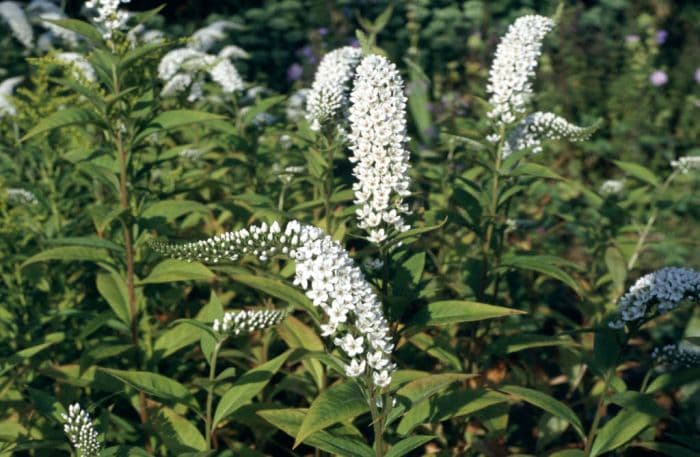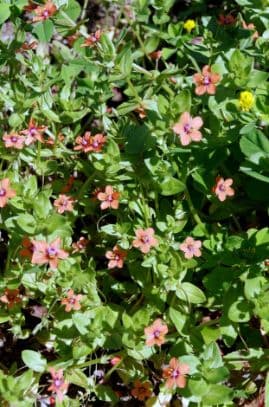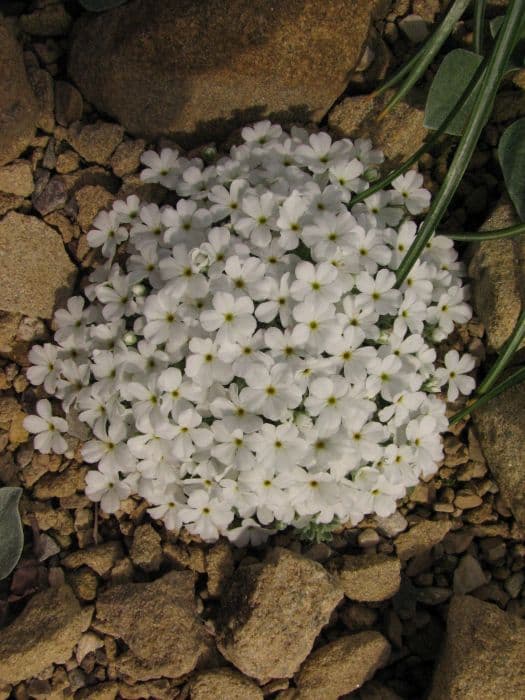Gooseneck Loosestrife Lysimachia clethroides

ABOUT
The plant known most commonly as the gooseneck loosestrife is a perennial herbaceous plant notable for its unique flower spikes and attractive foliage. The leaves of this plant are lance-shaped, sporting a vibrant green shade, which adds texture and color to garden spaces throughout the season. The most striking feature of gooseneck loosestrife is its inflorescence, which consists of numerous tiny, star-shaped white flowers densely packed on elongated, curved spikes. These flower spikes have a distinctive arching appearance, resembling the neck of a goose, which gives the plant its common name. Blooming typically occurs in the summer, providing a refreshing, white floral display that adds elegance and interest to any planting area. The plant spreads via rhizomes and can form clumps, making it an effective ground cover in the right conditions. Despite its charming looks, it is important to note that gooseneck loosestrife can be quite aggressive in its growth habit, which might require management to prevent it from overtaking other plants in the garden.
About this plant
 Names
NamesFamily
Primulaceae
Synonyms
Gooseneck Loosestrife, Goose Neck Loosestrife, Gooseneck Yellow Loosestrife, Clethra Loosestrife
Common names
Lysimachia clethroides var. clethroides, Naumburgia clethroides, Naumburgia clethroides var. clethroides, Lysimachia fortunei, Lysimachia fortunei var. fortunei, Naumburgia fortunei.
 Toxicity
ToxicityTo humans
The plant commonly known as Gooseneck Loosestrife (Lysimachia clethroides) is not known to be toxic to humans. There is no widespread documentation of poisoning or adverse health effects resulting from the ingestion of any part of this plant in humans. However, it is generally recommended to avoid eating ornamental plants due to the potential presence of harmful chemicals used during cultivation.
To pets
Gooseneck Loosestrife (Lysimachia clethroides) is not specifically listed as toxic to pets, such as dogs and cats. There is no well-documented evidence that suggests this plant poses a substantial risk of poisoning if ingested by pets. However, as with humans, it is generally advised to prevent pets from consuming plants not intended for their diet, to avoid possible digestive upset or the ingestion of any harmful substances used in the growing process of the plant.
 Characteristics
CharacteristicsLife cycle
Perennials
Foliage type
Deciduous
Color of leaves
Green
Flower color
White
Height
2-3 feet (60-90 cm)
Spread
2-3 feet (60-90 cm)
Plant type
Herb
Hardiness zones
3-8
Native area
Asia
Benefits
 General Benefits
General Benefits- Attracts Pollinators: Lysimachia clethroides, commonly known as the Gooseneck Loosestrife, is beneficial for gardens as it attracts bees, butterflies, and other pollinators, which are vital for the pollination of many plants.
- Ornamental Value: The distinct gooseneck-shaped flowers and the lush foliage of the plant provide high ornamental value to gardens and landscapes.
- Naturalizing: Gooseneck Loosestrife has the ability to spread and naturalize in an area, filling in spaces and creating a full, lush garden display.
- Low Maintenance: Once established, this plant requires minimal care, making it a convenient choice for gardeners who prefer low-maintenance landscapes.
- Tolerance of Wet Soils: It thrives in moist and wet soil conditions, where many other plants might struggle, making it useful for challenging garden spots.
- Long Flowering Period: The plant has a relatively long blooming season, providing interest and color for an extended period during the summer months.
- Erosion Control: The spreading habit and robust growth can help prevent soil erosion on slopes and in areas where this might be a concern.
 Medical Properties
Medical Properties- This plant is not used for medical purposes.
 Air-purifying Qualities
Air-purifying QualitiesThis plant is not specifically known for air purifying qualities.
 Other Uses
Other Uses- Lysimachia clethroides, commonly known as Gooseneck Loosestrife, can be used as a natural dye for fabrics, providing a range of colors from green to yellow depending on the mordant used.
- The plant's dense growth habit makes it an effective ground cover, reducing soil erosion on slopes and in garden beds.
- Gooseneck Loosestrife can be planted along water features, such as ponds, to enhance the aesthetics and provide habitat for amphibians and insects.
- The stalks of Lysimachia clethroides can be used in fresh floral arrangements, with their distinctive curved inflorescences adding an interesting visual element.
- The dried seed heads of the plant can be used in dried flower arrangements due to their interesting shape and structural quality.
- Reflection ponds can benefit from the inclusion of this plant, as its sweeping flowers can create dramatic reflections on the water surface.
- In wildlife gardens, Gooseneck Loosestrife provides nectar for pollinators, including bees and butterflies, contributing to biodiversity.
- The plant can be used as a living mulch, suppressing weeds with its sprawling foliage while also retaining soil moisture.
- Lysimachia clethroides's extensive root system makes it useful for stabilizing the banks of streams and creeks to prevent erosion.
- As a teaching tool, Gooseneck Loosestrife can be used to demonstrate aggressive plant behavior and the importance of managing invasive species in native plantings.
Interesting Facts
 Feng Shui
Feng ShuiThe Gooseneck Loosestrife is not used in Feng Shui practice.
 Zodiac Sign Compitability
Zodiac Sign CompitabilityThe Gooseneck Loosestrife is not used in astrology practice.
 Plant Symbolism
Plant Symbolism- Guidance: The common name "Gooseneck Loosestrife" refers to the distinctive curve of the plant's flower spikes, recalling the shape of a goose's neck. This unusual form is sometimes seen as a symbol of finding guidance and direction in life's journey.
- Flexibility: The bending flower stems are also reminiscent of flexibility and adaptability, suggesting the ability to thrive despite life's challenges and changes.
- Persistence: Lysimachia clethroides is known for its vigorous growth habit, often considered invasive in some areas. This characteristic can be a metaphor for persistence and determination.
- Purity: The white flowers of Gooseneck Loosestrife can be associated with purity and innocence, a common symbolism for white-flowering plants in many cultures.
- Friendship: In floral language, Lysimachia occasionally represents the bonds of friendship, possibly due to its ability to spread and connect with other plants in its vicinity, much like the intertwining relationships between friends.
 Water
WaterGooseneck loosestrife requires consistent moisture and should be watered thoroughly when the top inch of soil feels dry to the touch. This usually translates to watering once a week, but frequency may increase during hot, dry spells, to possibly two or three times a week. When watering, apply water slowly at the base of the plant until the soil is saturated. In terms of the amount, this generally means providing about one gallon of water per plant for each watering session, ensuring it reaches the deeper roots without causing waterlogging.
 Light
LightGooseneck loosestrife thrives in full sun to partial shade conditions. The ideal spot would receive morning sunlight and some afternoon shade, especially in hotter climates. Too much shade can lead to leggy growth and fewer flowers, while too much direct, harsh sunlight can scorch the leaves.
 Temperature
TemperatureGooseneck loosestrife favors temperate climates and can handle a wide temperature range. It typically can survive minimum temperatures around 40 degrees Fahrenheit and is hardy up to USDA zone 4. The ideal temperature conditions for this perennial plant are between 60 to 75 degrees Fahrenheit for optimal growth and flowering.
 Pruning
PruningPruning gooseneck loosestrife is necessary to maintain plant health and prevent aggressive spreading. Cut back the plant in late winter or early spring before new growth starts. This helps to remove any dead or damaged stems and can control its growth. Pruning is also beneficial after flowering to prevent self-seeding, and should be done annually for the best results.
 Cleaning
CleaningAs needed
 Soil
SoilGooseneck Loosestrife (Lysimachia clethroides) thrives best in a soil mix that is rich in organic matter, moist, and well-draining. A good mix would consist of garden loam, peat, and perlite or vermiculite to ensure drainage and aeration. The ideal pH range for this plant is slightly acidic to neutral, between 5.5 and 7.0.
 Repotting
RepottingGooseneck Loosestrife should be repotted every 2 to 3 years to replenish its soil and to accommodate its spreading growth habit. It's best to repot in the spring before the new growth starts.
 Humidity & Misting
Humidity & MistingGooseneck Loosestrife prefers moderate to high humidity levels but is quite adaptable to various conditions provided it is not in extreme dryness.
 Suitable locations
Suitable locationsIndoor
Provide bright light, keep moist.
Outdoor
Plant in partial shade, moist soil.
Hardiness zone
3-8 USDA
 Life cycle
Life cycleThe life of Lysimachia clethroides, commonly known as Gooseneck Loosestrife, begins with seed germination in late winter to early spring, requiring a period of cold stratification to break dormancy. Following germination, it develops into a rosette of leaves at the soil surface, and as temperatures rise, it develops a stem and foliage, experiencing vegetative growth. During late spring to summer, it enters the reproductive stage, characterized by elongated flower spikes with numerous tiny, star-shaped white flowers that attract pollinators. After pollination, the flowers develop into small capsules containing seeds, which mature by late summer to early fall. The plant dies back to the ground after the first frost, becoming dormant over the winter months. The cycle resumes the next spring with new growth emerging from the perennial root system or from the freshly dispersed seeds that will establish new plants.
 Propogation
PropogationPropogation time
Spring to Summer
Lysimachia clethroides, commonly known as Gooseneck Loosestrife, is best propagated by division, which ideally should be performed in the spring as new growth appears. To propagate by division, carefully dig up an established clump and gently tease apart the root ball into smaller segments, making sure each segment has a portion of roots attached. Replant each divided section at the same depth it was originally growing, spacing them about 18 to 24 inches (approximately 45 to 60 centimeters) apart to allow for spreading. Water the newly planted divisions well to help establish them. Division not only helps to propagate Gooseneck Loosestrife but also controls its spread, as it can become invasive if not managed.









